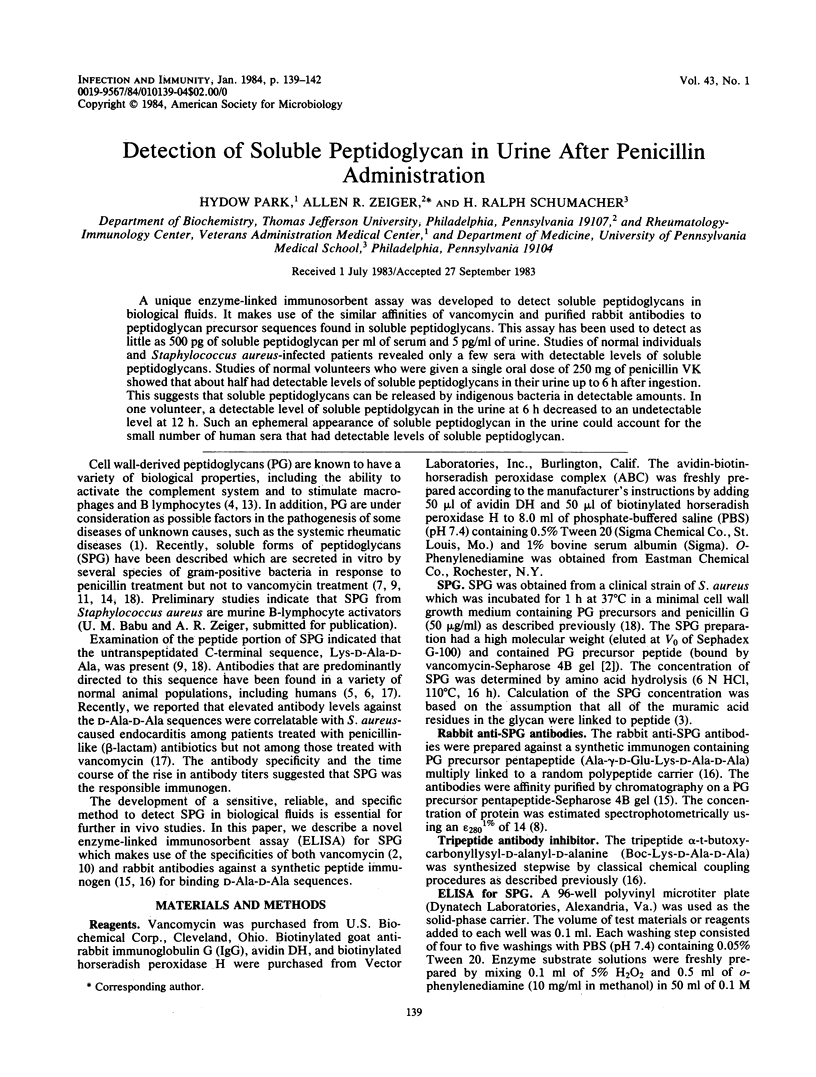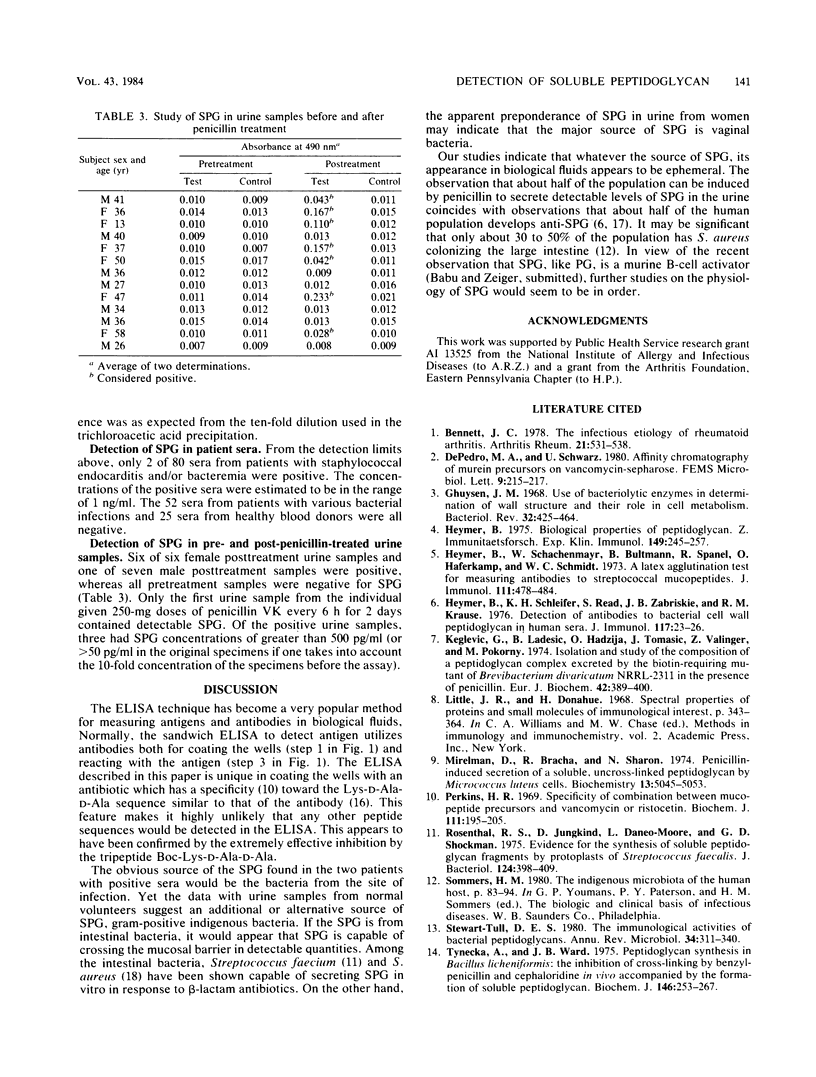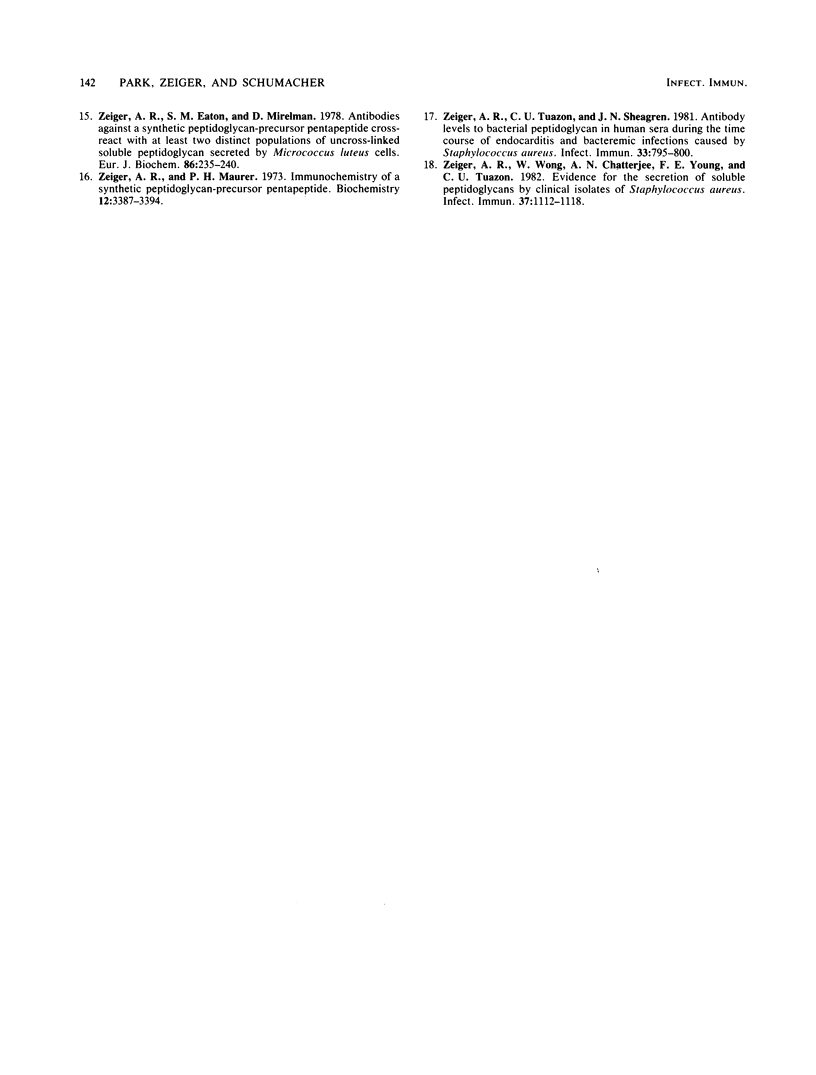Abstract
A unique enzyme-linked immunosorbent assay was developed to detect soluble peptidoglycans in biological fluids. It makes use of the similar affinities of vancomycin and purified rabbit antibodies to peptidoglycan precursor sequences found in soluble peptidoglycans. This assay has been used to detect as little as 500 pg of soluble peptidoglycan per ml of serum and 5 pg/ml of urine. Studies of normal individuals and Staphylococcus aureus-infected patients revealed only a few sera with detectable levels of soluble peptidoglycans. Studies of normal volunteers who were given a single oral dose of 250 mg of penicillin VK showed that about half had detectable levels of soluble peptidoglycans in their urine up to 6 h after ingestion. This suggests that soluble peptidoglycans can be released by indigenous bacteria in detectable amounts. In one volunteer, a detectable level of soluble peptidoglycan in the urine at 6 h decreased to an undetectable level at 12 h. Such an ephemeral appearance of soluble peptidoglycan in the urine could account for the small number of human sera that had detectable levels of soluble peptidoglycan.
Full text
PDF



Selected References
These references are in PubMed. This may not be the complete list of references from this article.
- Bennett J. C. The infectious etiology of rheumatoid arthritis. New considerations. Arthritis Rheum. 1978 Jun;21(5):531–538. doi: 10.1002/art.1780210507. [DOI] [PubMed] [Google Scholar]
- Ghuysen J. M. Use of bacteriolytic enzymes in determination of wall structure and their role in cell metabolism. Bacteriol Rev. 1968 Dec;32(4 Pt 2):425–464. [PMC free article] [PubMed] [Google Scholar]
- Heymer B. Biological properties of the peptidoglycan. Z Immunitatsforsch Exp Klin Immunol. 1975 Jul;149(2-4):245–257. [PubMed] [Google Scholar]
- Heymer B., Schachenmayr W., Bültmann B., Spanel R., Hafferkamp O., Schmidt W. C. A latex agglutination test for measuring antibodies to Streptococcal mucopeptides. J Immunol. 1973 Aug;111(2):478–484. [PubMed] [Google Scholar]
- Heymer B., Schleifer K. H., Read S., Zabriskie J. B., Krause R. M. Detection of antibodies to bacterial cell wall peptidoglycan in human sera. J Immunol. 1976 Jul;117(1):23–26. [PubMed] [Google Scholar]
- Keglević D., Ladesić B., Hadzija O., Tomasić J., Valinger Z., Pokorny M., Naumski R. Isolation and study of the composition of a peptidoglycan complex excreted by the biotin-requiring mutant of Brevibacterium divaricatum NRRL-2311 in the presence of penicillin. Eur J Biochem. 1974 Mar 1;42(2):389–400. doi: 10.1111/j.1432-1033.1974.tb03351.x. [DOI] [PubMed] [Google Scholar]
- Mirelman D., Bracha R., Sharon N. Penicillin-induced secretion of soluble, uncross-linked peptidoglycan by Micrococcus luteus cells. Biochemistry. 1974 Nov 19;13(24):5045–5053. doi: 10.1021/bi00721a028. [DOI] [PubMed] [Google Scholar]
- Perkins H. R. Specificity of combination between mucopeptide precursors and vancomycin or ristocetin. Biochem J. 1969 Jan;111(2):195–205. doi: 10.1042/bj1110195. [DOI] [PMC free article] [PubMed] [Google Scholar]
- Rosenthal R. S., Jungkind D., Daneo-Moore L., Shockman G. D. Evidence for the synthesis of soluble peptidoglycan fragments by protoplasts of Streptococcus faecalis. J Bacteriol. 1975 Oct;124(1):398–409. doi: 10.1128/jb.124.1.398-409.1975. [DOI] [PMC free article] [PubMed] [Google Scholar]
- Stewart-Tull D. E. The immunological activities of bacterial peptidoglycans. Annu Rev Microbiol. 1980;34:311–340. doi: 10.1146/annurev.mi.34.100180.001523. [DOI] [PubMed] [Google Scholar]
- Tynecka Z., Ward J. B. Peptidoglycan synthesis in Bacillus licheniformis. The inhibition of cross-linking by benzylpenicillin and cephaloridine in vivo accompanied by the formation of soluble peptidoglycan. Biochem J. 1975 Jan;146(1):253–267. doi: 10.1042/bj1460253. [DOI] [PMC free article] [PubMed] [Google Scholar]
- Zeiger A. R., Eaton S. M., Mirelman D. Antibodies against a synthetic peptidoglycan-precursor pentapeptide cross-react with at least two distinct populations of uncross-linked soluble peptidoglycan secreted by Micrococcus luteus cells. Eur J Biochem. 1978 May;86(1):235–240. doi: 10.1111/j.1432-1033.1978.tb12304.x. [DOI] [PubMed] [Google Scholar]
- Zeiger A. R., Maurer P. H. Immunochemistry of a synthetic peptidoglycan-precursor pentapeptide. Biochemistry. 1973 Aug 28;12(18):3387–3394. doi: 10.1021/bi00742a004. [DOI] [PubMed] [Google Scholar]
- Zeiger A. R., Tuazon C. U., Sheagren J. N. Antibody levels to bacterial peptidoglycan in human sera during the time course of endocarditis and bacteremic infections caused by Staphylococcus aureus. Infect Immun. 1981 Sep;33(3):795–800. doi: 10.1128/iai.33.3.795-800.1981. [DOI] [PMC free article] [PubMed] [Google Scholar]
- Zeiger A. R., Wong W., Chatterjee A. N., Young F. E., Tuazon C. U. Evidence for the secretion of soluble peptidoglycans by clinical isolates of Staphylococcus aureus. Infect Immun. 1982 Sep;37(3):1112–1118. doi: 10.1128/iai.37.3.1112-1118.1982. [DOI] [PMC free article] [PubMed] [Google Scholar]


